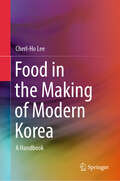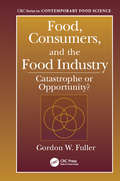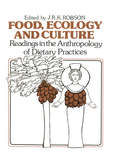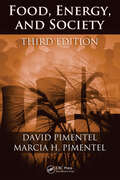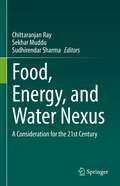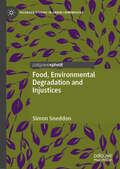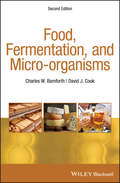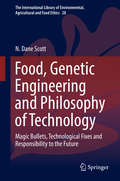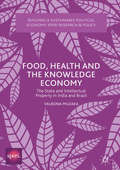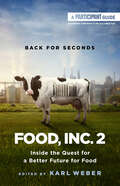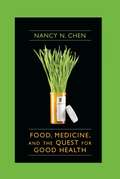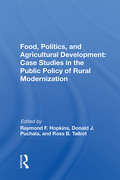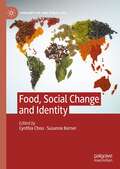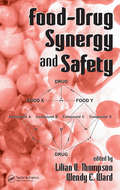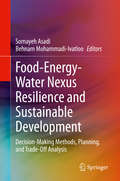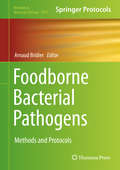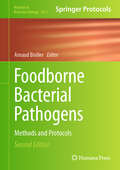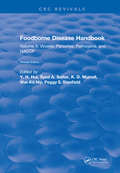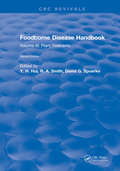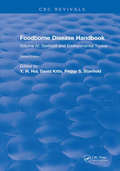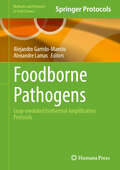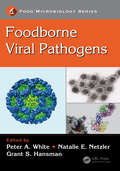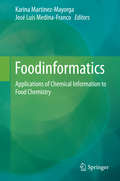- Table View
- List View
Food in the Making of Modern Korea: A Handbook
by Cherl-Ho LeeThis handbook offers an updated and comprehensive presentation of knowledge on Korean modern and contemporary food history. It covers the changes in food availability, nutrition, and the health status of Koreans, and the Korean food industry's development from the late period of Joseon dynasty in the mid-19th century, to the present. This period includes the severe poverty and food shortage of the Joseon dynasty, followed by the Japanese invasion, Independence and the South-North division, the Korean war, and rapid industrial development. The influence of national and international environments and political changes during the last 150 years on the Korean food security and the nutritional situation of the people is demarcated. In doing so, the author makes novel suggestions on possible contributions to alleviate the world food crisis in the future. Relevant to food historians and food scientists, and East Asian studies scholars with a particular interest in Korean culture and history,this is a pioneering work that elucidates the driving forces for the development and betterment of Korean society—through food acquisition.
Food, Consumers, and the Food Industry: Catastrophe or Opportunity?
by Gordon W. FullerDuring the past, there have been many changes in food availability, production and selection around the world. These changes, such as genetically modified foods, raise questions about their long-range implications. How will they affect the worldwide economics and management of agriculture? food legislation? the environment? the determination of foo
Food, Ecology and Culture: Readings in the Anthropology of Dietary Practices (Food and Nutrition in History and Anthropology)
by J. R. K. RobsonFirst published in 1980. Routledge is an imprint of Taylor & Francis, an informa company.
Food, Energy, and Society
by David Pimentel Marcia H. PimentelSince the publication of the first edition of Food, Energy, and Society, the world's natural resources have become even more diminished due to the rapid expansion of the global human population. We are faced with dwindling food supplies in certain geographic areas, increasing pressure on energy resources, and the imminent extinction of many
Food, Energy, and Water Nexus: A Consideration for the 21st Century
by Chittaranjan Ray Sekhar Muddu Sudhirendar SharmaIn this book, major issues surrounding importance of water and energy for food security in the United States and India are described representing two extremes in yield, irrigation efficiency, and automation. The farming systems in these two countries face different risks in terms of climatic shifts and systems’ resiliency to handle the shocks. One may have comparative advantage over the other, but both are susceptible. Innovations in irrigation for food and fuel production, improvements in nitrogen and water use efficiency, and rural sociological issues are discussed here. We also look into some of the unintended consequences of high productivity agriculture in terms of surface and ground water quality and impacts on ecosystem services. Finally, we present ways to move forward to meet the food demands in the next half-century in both countries. As the current world population of 7 billion is expected to reach or exceed 10 billion in the next 40 years, there will be significant additional demand for food. A rising middle class and its preference for a meat-based diet also increases the demand for animal feed. This additional food and feed production needs special considerations in water and energy management besides the development of appropriate crop hybrids to withstand future climatic shifts and other environmental factors. A resilient agricultural landscapes will also be needed to withstand climatic fluctuations, disease pressures, etc. While the upper and many middle income countries have made significant improvements in crop yield due to pressurized irrigation and automation in farming systems, the lower income countries are struggling with yield enhancements due to such limitations. The rise in population is expected to be more in Sub-Sharan Africa and Middle East (Low to middle-income countries) where the crop yields are expected to be low.
Food, Environmental Degradation and Injustices: How the Way We Eat Will Destroy Us (Palgrave Studies in Green Criminology)
by Simon SneddonWhat if the global trade in key food commodities suddenly ceased? This book takes readers on a thought-provoking journey through the environmental, ethical, and social justice issues embedded in our food systems. From meat and seafood to staple crops like tomatoes, potatoes, palm oil, and soya, it explores how industrial agriculture and aquaculture drive deforestation, biodiversity loss, labour exploitation, and species injustice. Drawing on green criminology and eco-justice principles, the book uncovers how corporations, weak regulations, and economic inequalities sustain harmful practices—often legally sanctioned but morally indefensible. Through an innovative &“what-if&” approach, it challenges readers to rethink the true cost of their food and the power of their choices. This compelling book is essential reading for anyone concerned with sustainability, corporate accountability, and the future of global food production.
Food, Fermentation, and Micro-organisms
by David J. Cook Charles W. BamforthFermentation and the use of micro-organisms is one of the most important aspects of food processing – an industry that is worth billions of US dollars world-wide. Integral to the making of goods ranging from beer and wine to yogurt and bread, it is the common denominator between many of our favorite things to eat and drink. In this updated and expanded second edition of Food, Fermentation, and Micro-organisms, all known food applications of fermentation are examined. Beginning with the science underpinning food fermentations, the author looks at the relevant aspects of microbiology and microbial physiology before covering individual foodstuffs and the role of fermentation in their production, as well as the possibilities that exist for fermentation’s future development and application. Many chapters, particularly those on cheese, meat, fish, bread, and yoghurt, now feature expanded content and additional illustrations. Furthermore, a newly included chapter looks at indigenous alcoholic beverages. Food, Fermentation, and Micro-organisms, Second Edition is a comprehensive guide for all food scientists, technologists, and microbiologists working in the food industry and academia today. The book will be an important addition to libraries in food companies, research establishments, and universities where food studies, food science, food technology and microbiology are studied and taught.
Food, Genetic Engineering and Philosophy of Technology: Magic Bullets, Technological Fixes and Responsibility to the Future (The International Library of Environmental, Agricultural and Food Ethics #28)
by N. Dane ScottThis book describes specific, well-know controversies in the genetic modification debate and connects them to deeper philosophical issues in philosophy of technology. It contributes to the current, far-reaching deliberations about the future of food, agriculture and society. Controversies over so-called Genetically Modified Organisms (GMOs) regularly appear in the press. The biotechnology debate has settled into a long-term philosophical dispute. The discussion goes much deeper than the initial empirical questions about whether or not GM food and crops are safe for human consumption or pose environmental harms that dominated news reports. In fact, the implications of this debate extend beyond the sphere of food and agriculture to encompass the general role of science and technology in society. The GM controversy provides an occasion to explore important issues in philosophy of technology. Researchers, teachers and students interested in agricultural biotechnology, philosophy of technology and the future of food and agriculture will find this exploration timely and thought provoking.
Food, Health and the Knowledge Economy: The State and Intellectual Property in India and Brazil (Building a Sustainable Political Economy: SPERI Research & Policy)
by Valbona MuzakaThis book opens a window into how two ambitious countries – India and Brazil – are seeking to become knowledge powers in the 21st century. As the knowledge economy became the preferred way of conceptualising the economy and its future direction, in the more economically-advanced countries, our search for understanding also followed the same direction. This generated a body of work that has neglected countries that, like India and Brazil, are attempting to make the leap into knowledge economies. Muzaka explores these motivations and the ways in which they have inspired a number of institutional reforms in India and Brazil. The author offers an investigation of the role the state in shaping the respective intellectual property systems pertaining to the pharmaceutical and agro-biotechnology sectors and the multiple social conflicts that have unfolded as a result.
Food, Inc. 2: Inside the Quest for a Better Future for Food
by Participant and Karl WeberAn eye-opening guide to how America feeds itself and an essential companion book to the new documentary America&’s food system is broken, harming family farmers, workers, the environment, and our health. But it doesn&’t have to be this way. Here, brilliant innovators, scientists, journalists and activists explain how we can create a hopeful new future for food, if we have the courage to seize the moment. In 2008, the award-winning documentary Food, Inc. shook up our perceptions of what we ate. Now, the movie&’s timely sequel and this new companion book will address the remarkable developments in the world of food—from lab-grown meat to the burgeoning food sovereignty movement—that have unfolded since then. Featuring thought-provoking original essays from: Michael Pollan • Eric Schlosser • David E. Kelley and Andrew Zimmern • Senator Cory Booker • Sarah E. Lloyd • Carlos A. Monteiro and Geoffrey Cannon • Lisa Elaine Held • Larissa Zimberoff • Saru Jayaraman • Christiana Musk • Nancy Easton • Leah Penniman • David LeZaks and Lauren Manning • The Coalition of Immokalee Workers • Michiel Bakker • Danielle Nierenberg This book is the perfect roadmap to understanding not only our current dysfunctional food system, but also what each of us can do to help reform it.
Food, Media and Contemporary Culture: The Edible Image
by Peri BradleyFood, Media and Contemporary Culture is designed to interrogate the cultural fascination with food as the focus of a growing number of visual texts that reveal the deep, psychological relationship that each of us has with rituals of preparing, presenting and consuming food and images of food.
Food, Medicine, and the Quest for Good Health: Nutrition, Medicine, and Culture
by Nancy ChenWhat we eat, how we eat, where we eat, and when we eat are deeply embedded cultural practices. Eating is also related to how we medicate. The multimillion-dollar diet industry offers advice on how to eat for a better body and longer life, and avoiding harmful foods (or choosing healthy ones) is considered separate from consuming medicine-another multimillion-dollar industry. In contrast, most traditional medical systems view food as inseparable from medicine and regard medicinal foods as the front line of healing. Drawing on medical texts and food therapy practices from around the world and throughout history, Nancy N. Chen locates old and new crossovers between food and medicine in different social and cultural contexts. The consumption of spices, sugar, and salt was once linked to specific healing properties, and trade in these commodities transformed not just the political economy of Europe, Asia, and the New World but local tastes and food practices as well. Today's technologies are rapidly changing traditional attitudes toward food, enabling the cultivation of new admixtures, such as nutraceuticals and genetically modified food, that link food to medicine in novel ways. Chen considers these developments against the evolving food regimes of the diet industry in order to build a framework for understanding diet as individual practice, social prescription, and political formation.
Food, Politics, And Agricultural Development: Case Studies In The Public Policy Of Rural Modernization
by Donald J. Puchala Raymond F. Hopkins Ross B. TalbotThis collection of studies on the politics of agricultural development in regions of Asia and Africa emphasizes the need for steady and significant increases in food production in the developing countries. It is a set of exercises in the comparative analysis of agricultural modernization policies.
Food, Social Change and Identity (Consumption and Public Life)
by Susanne Kerner Cynthia ChouUnlike food publications that have been more organized along regional or disciplinary lines, this edited volume is distinctive in that it brings together anthropologists, archaeologists, area study specialists, linguists and food policy administrators to explore the following questions: What kinds of changes in food and foodways are happening? What triggers change and how are the changes impacting identity politics? In terms of scope and organization, this book offers a vast historical extent ranging from the 5th mill BCE to the present day. In addition, it presents case studies from across the world, including Asia, the Pacific, the Middle East, Europe and America. Finally, this collection of essays presents diverse perspectives and differing methodologies. It is an accessible introduction to the study of food, social change and identity.
Food-Drug Synergy and Safety
by Lilian U. Thompson Wendy E. WardScientists, health professionals, and consumers are increasingly interested in the relationships between food components and food-drug combinations as they strive to find more effective ways to prevent or treat chronic disease. As one of the first unified and in-depth sources in this emerging topic, Food-Drug Synergy and Safety explores the vast po
Food-Energy-Water Nexus Resilience and Sustainable Development: Decision-Making Methods, Planning, and Trade-Off Analysis
by Behnam Mohammadi-Ivatloo Somayeh AsadiThis book presents readers with an integrated modeling approach for analyzing and understanding the interconnection of water, energy, and food resources and discusses the relationship between resilience and sustainability of the food- energy –water (FEW) system. Authors provide novel frameworks, models, and algorithms designed to balance the theoretical and applicative aspects of each chapter. The book covers an integrated modeling approach for FEW systems along with developed methods, codes, and planning tools for designing interdependent energy, water and food systems. In-depth chapters discuss the impact of renewable energy resources in FEW systems, sustainable design and operation, net zero energy buildings, and challenges and opportunities of the FEW nexus in the sustainable development of different countries. This book is useful for graduate students, researchers, and engineers seeking to understand how sustainable FEW systems contribute to the resilience of these systems and help policy and design makers allocate and prioritize resources in an integrated manner across the food, energy, and water sectors.
Foodborne Bacterial Pathogens: Methods and Protocols (Methods in Molecular Biology #1918)
by Arnaud BridierThis volume presents a compilation of various representative techniques and approaches currently used to study bacterial foodborne pathogens. Chapters guide the reader through bacterial pathogen detection and quantification in food, molecular, phenotypic, metabolic characterization of food pathogens, and ecology of foodborne bacterial pathogens. Written in the highly successful Methods in Molecular Biology series format, chapters include introductions to their respective topics, lists of the necessary materials and reagents, step-by-step, readily reproducible laboratory protocols, and tips on troubleshooting and avoiding known pitfalls.Authoritative and cutting-edge, Foodborne Bacterial Pathogens : Methods and Protocols aims to server as a guide both for researchers, students, and those in the food industry who want to have an overview of current approaches and protocols used to study bacterial foodborne pathogens.
Foodborne Bacterial Pathogens: Methods and Protocols (Methods in Molecular Biology #2852)
by Arnaud BridierThis updated volume presents a compilation of various representative techniques and approaches currently used to study bacterial foodborne pathogens. Chapters guide the reader through bacterial pathogen detection and quantification in food, molecular, phenotypic, metabolic characterization of food pathogens, and ecology of foodborne bacterial pathogens. Written in the highly successful Methods in Molecular Biology series format, chapters include introductions to their respective topics, lists of the necessary materials and reagents, step-by-step, readily reproducible laboratory protocols, and key tips on troubleshooting and avoiding known pitfalls. Authoritative and cutting-edge, Foodborne Bacterial Pathogens: Methods and Protocols, Second Edition aims to ensure successful results in the further study of this vital field.
Foodborne Disease Handbook, Second Edition: Volume I: Bacterial Pathogens (Diseases Caused By Bacterial Ser.)
by Y. H. HuiContains new chapters on the role of U. S. poison centers in bacterial exposures; bacteria biota in foods; salmonellosis in animals; human salmonellosis; vibro cholerae; vibrio vulnificus; and more.
Foodborne Disease Handbook: Volume II: Viruses, Parasites, Pathogens, and HACCP
by Y. H. HuiA study of foodborne disease, focusing on viruses, parasites, pathogens and HACCP. This second edition contains new chapters on the role of US poison centres in viral exposures, detection of human enteric viruses in foods, environmental consideration in preventing foodborne spread of hepatitis A, seafood parasites, HACCP principles and control programmes for foodservice operations, and more.
Foodborne Disease Handbook: Volume III: Plant Toxicants (Diseases Caused By Bacterial Ser.)
by Y. H. HuiThe Foodborne Disease handbook, Second Edition, Revised and Expanded, could not be appearing at a more auspicious time. Never before has the campaign for food safety been pursued so intensely on so many fronts in virtually every country around the world. This new edition reflects at least one of the many aspects of that intense and multifaceted campaign: namely, that research on food safety has been very productive in the years since the first edition appeared. The Handbook is now presented in four volumes instead of the three of the 1994 edition. Volume 3 of this series of books on food gums and hydrocolloids continues with a pragmatic coverage of three important categories of gum, i.e., the cellulose gums, the plant seed gums, and the pectins. The chemical, physical and functional properties of each of the important food gums in these categories are reviewed and discussed in relation with their utility in food product applications. The four volumes are composed of 86 chapters, a 22% increase over the 67 chapters of the first edition. Much of the information in the first edition has been carried forward to this new edition because that information is still as reliable and pertinent as it was in 1994. This integration of the older data with the latest research findings gives the reader a secure scientific foundation on which to base important decisions affecting the public‘s health.
Foodborne Disease Handbook: Volume IV: Seafood and Environmental Toxins (Diseases Caused By Bacterial Ser.)
by Y. H. HuiA study of foodborne disease, focusing on seafood and environmental toxins. This second edition discusses fish, shellfish, and freshwater and marine organisms affected by agricultural and food processing products, including raw sewage, industrial effluents, trash and garbage, pesticide runoff from crop lands and top soils, and more.
Foodborne Pathogens: Loop-mediated Isothermal Amplification Protocols (Methods and Protocols in Food Science)
by Alejandro Garrido-Maestu Alexandre LamasThis volume details reliable protocols for the successful implementation of LAMP assays for the detection of the most relevant foodborne pathogens and antibiotic resistance microorganisms. Chapters guides the reader through different types of detection strategies, from the most classical ones to the most recent ones focused on color change or even the implementation of nanomaterials are covered, along with specific applications in point-of care devices and even primer design. Written in the format of the Methods and Protocols in Food Science series, chapters list necessary materials and methods for readily reproducible protocols. Authoritative and cutting-edge, Food Bourne Pathogen: Loop-mediated Isothermal Amplification Protocols aims to be comprehensive guide for researchers in the field. Authoritative andcutting-edge, Loop-mediated isothermal amplification: foodborne pathogendetection and characterization aims to provide comprehensive and updated state-of-art methodologies for food analysis.
Foodborne Viral Pathogens (Food Microbiology)
by Peter White Natalie Netzler Grant HansmanViral transmission through contaminated food and water claims hundreds of thousands of lives every year, particularly affecting children in developing nations. Foodborne viral pathogens are associated with gastroenteritis and hepatitis, causing widespread epidemics that affect all populations and demographics worldwide. Foodborne Viral Pathogens comprehensively covers the predominant etiological viral agents of foodborne disease, including norovirus, hepatitis A virus, hepatitis E virus, astrovirus, sapovirus and rotavirus, and several emerging viruses and prions. By improving food safety awareness and viral detection, and through promotion of global food safety standards, our ability to cope with and control foodborne disease will be enhanced. Foodborne Viral Pathogens includes a detailed review of the molecular biology, potential vaccines, and available antiviral treatments of all major foodborne viral pathogens and prions. Written by specialists and leading virologists, this book features techniques used for typing, viral detection, strategies for control, and viral risk assessments. This book is intended as a detailed handbook for food microbiology and medical applications and will be a useful guide for anyone with an interest in foodborne disease.
Foodinformatics
by Karina Martinez-Mayorga José Luis Medina-FrancoThe explosion in the generation of information parallels the explosion of computational resources. The use of computers to collect, store and manipulate chemical information is at the heart of chemoinformatics. These methodologies, whose main target thus far has been the pharmaceutical field, are general and can be applied to other types of chemical data sets, such as those containing food chemicals. While the use of chemical information methodologies to address food-related challenges is still in its infancy, interest is growing and will continue to do so as the methods prove useful, particularly for providing practical solutions to food industry challenges. Foodinformatics gives an overview of basic concepts, applications, tools and perspectives of the emerging field of foodinformatics. The book is an important addition to the literature and will be of interest of food chemists, nutritionists, informaticians and scientists of related fields. About the Editors Karina Martínez-Mayorga, Instituto de Química, UNAM, Mexico City, México and Torrey Pines Institute for Molecular Studies, Port St. Lucie, FL, USA José Luis Medina-Franco, Instituto de Química, UNAM, México City, México, and Torrey Pines Institute for Molecular Studies, Port St. Lucie, FL, USA
